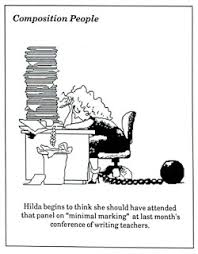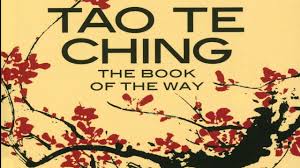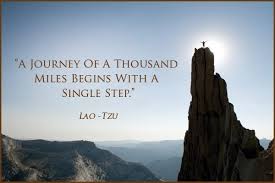Do Your Work and Step Back: The Tao of New Year’s Resolutions.
Call it procrastination. Call it getting caught in the perennial hermitage of grading student work at the end of the semester. This post is coming in at just around three weeks since conception. It’s almost fully viable. Is it too late to still muse about New Year’s Resolutions?
It’s a new calendar year, and like many years, I find myself with a fairly hefty slog of student work to grade before the end of the semester. Of course, there’s no one to point the finger at but myself. I assigned it, and my students–rightfully so–expect some sort of feedback or reward for their work.

I try not to let it bother me, but my mind loops back on itself. The number of times I run through the “checklist” in my head is often predicated on the amount of sleep I have. That I have 13 IA’s, 36 timed prompts,and a partridge in a pear tree remaining enters the cavern of my conscious mind–like when I’m in the middle of trying to stick a sweaty tree pose in Saturday yoga class.

Do your work and step back. One of my favorite lines from Tao te Ching (which not coincidentally is the subject of study in philosophy before exams). It’s a great mantra when you’re trying to drive through a pile of essays, but it mocks you when your yoga teacher is telling you to let whatever distracts you go and your mind is all of the sudden coming up with some really creative insight to use in class. Words from the Tao te Ching make for some really interesting points for contemplation, but they make for really shitty new year’s resolutions.

Not that I’m trying to hard for that anyway, which I think makes me feel good. This year, resolutions feel like continuing on the path that I’m on, doing more of the same in a more dedicated manner, which means that maybe I’m on the right path, or at least one that I’m not trying to find an exit ramp from. I mean, maybe I can resolve to have less work during Christmas break, but that’s more of a resolution for the new school year, not the new calendar year.

But as my mind wanders in Shivasana in that semi-conscious state, the stew of work and Taoist quips swirl in points that aren’t going to just go away because Kevin turns off the lights and says so in a cooing voice. Today at the beginning of class, someone identified their job as something they dread in their life. I don’t feel that way. I generally like my job and the creative and intellectual autonomy it provides (though the 7:15 start of class bullshit is for the birds). But the Tao doesn’t say “do your job and step back” (although in some translation, it probably does). This may seem like a distinction of splitting hairs, but the truth is that there are lots of people who have jobs–jobs that may become their de facto identity–that never provides them the fulfilling opportunity for meaningful work.
And while helping to shape the minds of young Americans is certainly valuable work, not all the work that those young minds are asked to endure in that process is valuable. And here’s where my return to the Tao and my lack of resolutions merge their streams into a mighty river finding the low points, sustaining all of life. Read along with my students if you like.

Untangle the Knots. (56) This metaphor has been all up in my craw recently. I think about an old rope I had in my camping gear that I bought to hang bear bags. Over time I used it to hang tarps and hang lamps and it got pretty tangled to the point where it was barely useful for the intent of its original purpose.
I watch my students as I give them a discussion structure for this book. They begin arguing about the minutiae of whether or not they are doing it right. They don’t realize that these discussion prompts are just ways to get to the ball rolling. They’re tying themselves in knots trying to get the details right that they’re barely discussing the text at all.
Class can be like this sometimes. We construct activities to move our students minds, but sometimes we can get so bogged down in the requirements we create that the learning becomes less useful. We get so fixated on perfecting the know that we forget the potential of the rope. The fact that students often eschew learning for grading is certainly symptomatic of this problem.
This year, we’ve been lucky in that our school system finally decided to get rid of the arcane pastiche of rules on writing and presenting known as the Grad Project. We are somewhat more free to create something new. One less know to untangle, but I’m sure we’ll find new ones. Over time, many knots get tangled in my teaching. Maybe it’s time to sit pensively and untangle some as opposed to putting new knots in the same rope.
Accept Disgrace Willingly/Hope is as hollow as Fear (13) Of course, when I start thinking like this, or when my mind starts exploding mid-Shivasana with new ideas for class, I’m thinking like Thoreau, building my castles in the air, then forcing myself to build the foundations. I don’t want to necessarily “let the thought pass” as many meditative leaders may quip because these thoughts and ideas are valuable insights. It’s so often that we choose the familiar because in the trenches of teaching, the familiar is available when the fatigue sets in and the creative portion of our teaching mind is limping along for the ride. Having any new ideas to inject into what can otherwise become a monotonous practice is invaluable.
I get excited. I construct new lessons. I think of new arrangements or projects. And in the end, sometimes they work and sometimes they don’t. What is exciting and new at one point will soon become old and stale. Sometimes, I look at old Prezis or Slides and they don’t make sense. What’s missing is the ardor–the verve–I had for the idea at the time.
Ideas that seem beautiful in their nascent blossom fail for any number of reasons. One of the best parts about teaching (aside from the exorbitant salary, of course) is the autonomy to create an environment that allows other humans to thrive and flourish. And if that fails, you have the opportunity to change and modify that environment again and again and again. But failure is inherent in a thousand different ways in this process.
“Hope is a thing with feathers,” said Emily Dickinson. Sometimes that’s a soaring eagle; sometimes it’s a clucking chicken laying rotten eggs. In any new idea, in any bright flash of seemingly genius insight, there is both the potential for earth-shattering transformation and abject ruinous despair. Most specifically, it can be because we as teachers sometimes set short-sighted standards for our students, setting curricular goals for them that may come in direct conflict with what they need as a person at that very time. Maybe learning to write a stellar claim comes at the time when a student needs to learn to be less contentious or find balance in their mental health. We only provide some of the nurturing; they will grow where they will, which often runs afoul of what we think they need. Embracing all of this as the possibility is some understanding I’m trying to work through.

The Journey of a Thousand Miles Begins with a Single Step (64)/ Do your work and step back (9). I Joke with my students that the first quote is often the stuff of inspirational posters, but in the context of the text it means quite the opposite. Rather than it being a kick in the butt to get off the couch and start the new work-out routine or start writing that new novel because–damn it–it’s January, and that’s when it’s popular to talk about these things, the Tao in full context reminds us that all great entanglements, be they problems or achievements, start small. And perhaps if you need a new journey, taking that first step is what you need.
But that’s not where my head is for the New Year. I don’t know that I need new resolutions because I don’t know that I currently need new paths. To completely mix metaphors, this path has me a place where I feel that I have methodically planting seeds. The Yoga Sutras often speak of this as the start of all manifestation. I take stock of my life as we pass into a new decade and see that I’m doing a lot of the things that I want to do, and any goals that I currently have are being nurtured. In that regard, I don’t need a new direction, but a patient movement to continue nurturing the seeds that are planted and to be aware when I am not. In that case, “more of the same” seems as perfect a resolution as I could figure.
To that end, I don’t need to torture myself with an endless mental to-do list of tasks to complete. In that case, I have work to do in nurturing the seeds already planted. This path doesn’t need any new off-ramps or drastic re-direction.I will endeavor to continue on this path, to do that work, then step back, and allow myself to grow in the direction that goes.

Recent Comments